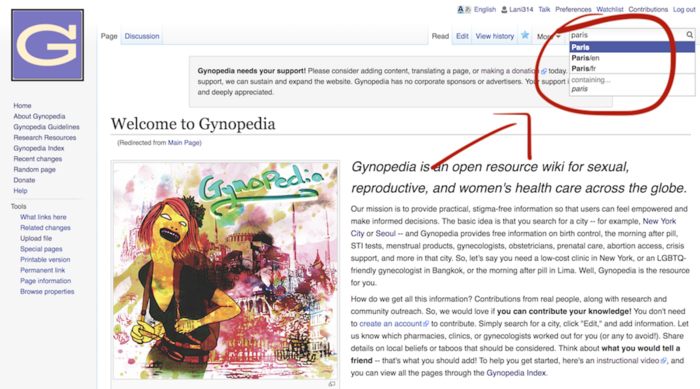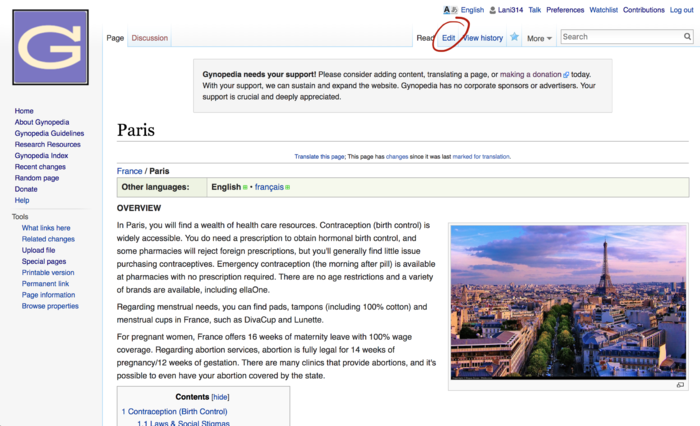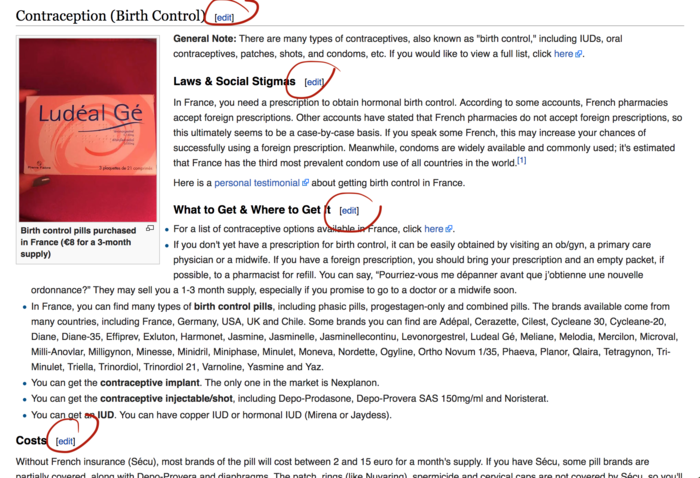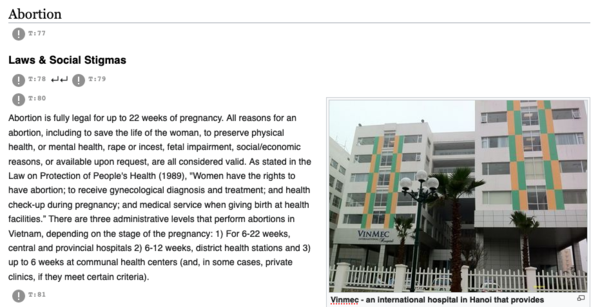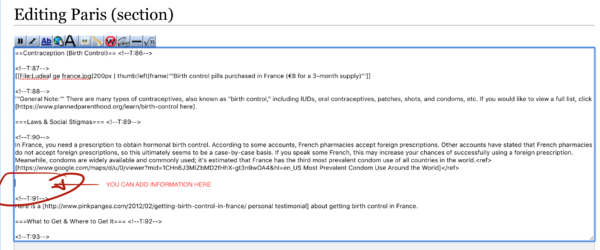Gynopedia needs your support! Please consider contributing content, translating a page, or making a donation today. With your support, we can sustain and expand the website. Gynopedia has no corporate sponsors or advertisers. Your support is crucial and deeply appreciated.
Contribute
SHARE YOUR KNOWLEDGE!
Did you know that it's super easy to add content to Gynopedia?
You don't need to create an account AND you don't need to be a medical "expert."
You simply need to have useful and reliable information to share -- so, check out the guide below!
How to Contribute Content
1. Choose Editing Type
Do you want to edit completely anonymously? If you want to be 100% anonymous, you should first create a Gynopedia account -- it's super easy, and all of your edits will be anonymous, since they'll be under your username. If you don't care about anonymity, you can edit immediately without creating an account. Your edits will be under your IP address.
2. Search for a Location
After you've either created an account or decided to not create an account, you're ready to begin editing. As a first step, you should search for the city or country page you want to edit. To do this, go to the Search bar (in the top right corner), and type in the name of the location (for example, "Paris"). If the page has been translated into multiple languages, you may see multiple entries for the page. To edit the original English page, select the first search result that you see (e.g. "Paris").
2. Begin Editing
Once you're on a page, you can begin editing the page. You can either choose to edit the whole page (click the "Edit" link at top of page) or a section of the page (click the "Edit" link for a particular section). Note that if you click "Edit" you will be given a visual view of the page to edit. If you click "Edit Source," you will be given a page to edit in wikitext. For beginner wiki editors, it is recommended to use the visual editing view.
3. Add Information
Once you have clicked "Edit," you'll see that the page changes to the edit view. You can now type in the information that you want to add. If you don't know what to add, think about this way: What would you want a friend to know? What's crucial, reliable, and real information that can help people in a time of need?
4. Add Citations
Once you have added information, you should make sure you have cited your sources. Generally, if you have added any official information about history, policies, or statistics, you should cite your sources from veritable and trustworthy sources (likes newspaper publications, academic journals, and reports from the UN, WHO, nonprofits, and NGOs, etc).
Citations in VisualEditor
Click on "Cite" in the editor toolbar. Then, you can add information on the citation, such as copy-pasting the URL of the reference or adding the name of the book reference.
Citations in Source Editor
Here's the format for adding an individual citation:
Childcare in Sweden is blah blah blah.<ref>[http://www.nytimes.com/how-swedish-childcare-works New York Times: How Swedish Childcare Works]</ref>
If you will use the same source multiple times, here is how you cite the source (the first time):
Childcare in Sweden is blah blah blah.<ref name="swedish-childcare">[http://www.nytimes.com/how-swedish-childcare-works New York Times: How Swedish Childcare Works]</ref>
Once you have cited the reference the first time, here is how you cite the same reference (subsequent times):
<ref name="swedish-childcare" />
The citations will appear as a footnote in the "References" section, which can be found at the bottom fo the page. To learn more about adding citations, check out this article on Cite extension.
5. Save Changes
Once you're done with the edits, scroll to the bottom and press "Save page." You can also preview how your changes will look before saving, if you click "Show preview" (just remember to click "Save page" afterward).
6. Review Changes
Your changes will be immediately saved on the page. Make sure to review your changes and confirm that they were saved correctly. If you want to make any changes, you can click "Edit" to update the page. Note that your edits will be archived under your username (if you created an account) or your IP Address (if you didn't create an account).
7. You're done!
You should now be finished. Moderators of Gynopedia will review your changes and confirm that the edits are not spam or abusive content. They'll also make sure that the information is relevant and reliable to the community.
Additional Resources
- If you want to get a sense of some of the sources we commonly use to conduct research and develop content for Gynopedia pages, please visit the Research Resources pages.
- If you want to know more about Mediawiki (the software that Gynopedia is built on) and how it works overall, click here.
- If you want to know more about open source software, click here.
